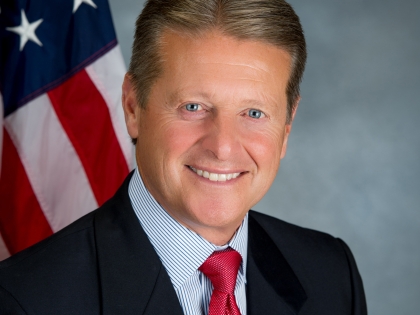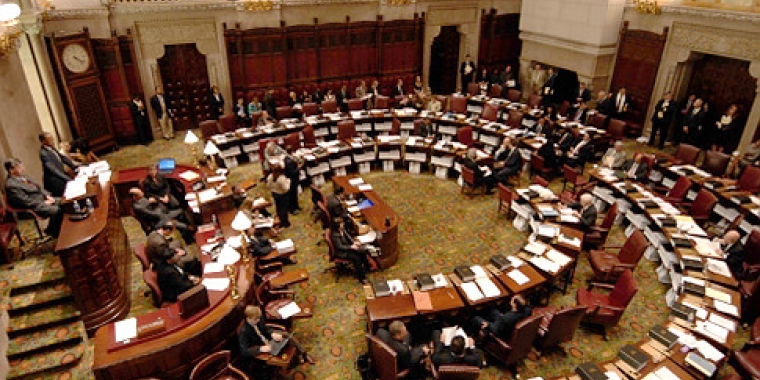
Senator Gallivan says New Legislation will Combat Heroin & Opioid Abuse
Jim Ranney
June 20, 2016

Senator Patrick M. Gallivan (R-C-I, Elma) says new legislation will help combat heroin and prescription opioid abuse across New York State. Under an agreement reached by legislative leaders and the governor, first-time opioid prescriptions would be limited from 30 days to 7 days, barriers to treatment would be eliminated and education efforts would be expanded.
“Too many lives have been lost and too many families have been devastated by heroin and opioid addiction,” Gallivan said. “The only way to address this crisis is through a united effort of prevention, education and treatment. As a former State Trooper and Sheriff of Erie County, and as a member of the Joint Task Force on Heroin and Opioid Addiction, I fully support these bills to combat this epidemic.”
The package of three bills includes initiatives dealing with drug abuse prevention, education and access to treatment and contains the following requirements and provisions.
Continuing Education on Addiction & Pain Management for All Prescribers
Requires every person licensed under Title VIII of the education law in possession of a registration number from the Drug Enforcement Administration (DEA), and every medical resident who is prescribing under a facility registration number from the DEA to complete three hours of course work or training in pain management, palliative care and addiction approved by the Department of Health (DOH).
The Commissioner of Health is required to consult with the Commissioners of Education and the Office of Alcoholism and Substance Abuse Services (OASAS) to establish standards and approve course work and training, which must be published on DOH’s website.
Consumer Education
Requires OASAS in consultation with DOH, to create and make available to pharmacies educational materials regarding the dangers of misuse and the potential for addiction to prescription controlled substances, available treatment resources, and proper disposal.
Requires these materials to be distributed when a controlled substance is dispensed and allows the materials to be disseminated electronically at the consumer’s option.
Initial Opioid Prescriptions Limited to 7 Days
To address the issue of overprescribing medications for acute pain, this proposal would require an authorized practitioner to limit the initial prescription of certain opioids to seven days. The practitioner may prescribe any appropriate renewal, refill, or new prescription for the opioid or any other drug after the initial 7-day supply.
Any copayments or coinsurance collected for the 7-day initial prescription shall not exceed the copayment or coinsurance otherwise applicable to a 30-day supply of such medication.
Mandatory Reporting Requirements
Directs DOH to expand its reporting of opioid overdose data by tracking the number of opioid overdoses generally in addition the number of opioid overdose deaths.
The Department is also required to examine data regarding areas of the State experiencing high rates of opioid overdoses and if any areas of the State have reduced overdose rates after receiving State resources or services. These vital statistics must be sent to counties each quarter and will provide a greater understanding of the areas struggling most with this crisis, which will help to better allocate funding for prevention, treatment and recovery services.
Inpatient Services
Requires a minimum of 14 days coverage for inpatient treatment of substance use disorder (SUD) without prior approval or concurrent utilization review (UR) during such 14 days for in-network providers, provided that the facility notifies the insurer of both the admission and the initial treatment plan within 48 hours of the admission.
The facility would be required to perform daily clinical review of the patient, including the periodic consultation with the plans to ensure that the inpatient treatment is medically necessary for the patient.
The patient is responsible for only the copayment, coinsurance or deductible, required under the policy, and would otherwise have no financial obligation to the facility for any treatment charges. Any disagreement on the medical necessity of the inpatient stay during those fourteen days would need to be worked out between the facility and the insurer.
72-Hour Evaluation for Substance Use Disorder Care
Extends the amount of time a person can be held to receive emergency services related to substance use from 48 hours to 72 hours.
This bill also ensures the provision of adequate discharge planning from treatment facilities, provides individuals with the opportunity to seek further substance use treatment and requires the dissemination of information on the dangers of long term substance use and treatment resources.
“Non-Patient Specific” Naloxone Anti-Opioid Reversal Medicine
Provides a limited exemption from professional misconduct for licensed professionals who would otherwise be prohibited from administering drugs, to administer an opioid antagonist in an emergency situation.
Wraparound Services
Requires OASAS to enact the wraparound services demonstration program as required by Chapter 32 of the Laws of 2014.
The demonstration program would provide services to adolescents and adults for up to nine months after the successful completion of a treatment program.
These services would be in the form of case management services that address education, legal, financial, social, childcare, and other supports.
Coordinated Care (Discharge Planning)
Requires OASAS, in consultation with DOH to develop new or utilize existing educational materials to be provided to hospitals for distribution to patients who are confirmed to be suffering from SUD or appear to be suffering from SUD.
Requires hospitals to develop and distribute written policies and procedures, and train personnel who are in direct clinical contact with SUD patients in identifying, assessing and referring such individuals.
Requires hospitals to provide referral for SUD patients and coordinate with SUD services programs, and upon treatment, admission or discharge, inform such individuals of the availability of services that may be available to them through a substance use disorder treatment program.
Emergency Substance Use Disorder Medication Coverage
Requires coverage, without prior authorization, for an emergency 5-day supply of medications for the treatment of substance use disorder where an emergency condition exists.
Any copayments or coinsurance collected for the emergency supply shall not exceed the copayment or coinsurance otherwise applicable to a 30-day supply of such medication.
Naloxone/Opioid Reversal Medication Coverage
Requires insurance coverage of Naloxone prescribed to a person who is addicted to opioids and to his/her family member.
The Fiscal Year 2017 Enacted Budget included $30 million in additional funding initiatives for heroin and opiate use. Notable initiatives are:
$1.2 million - Twenty new Support Navigator programs statewide, assisting individuals and their families with navigating insurance and OASAS treatment systems (FY 2018 funding of $2 million);
$1.7 million - Twenty new On-Call Peer programs, assisting individuals with substance use disorders in emergency rooms in connecting to treatment (FY 2018 funding of $3 million);
$1.9 million - Eleven new Adolescent Clubhouses, providing safe and welcoming spaces for teens and young adults who are at risk, assisting in prevention and recovery efforts (FY 2018 funding of $2.6 million);
$3.2 million - Sixteen new Recovery Community and Outreach Centers, providing supports in a comfortable environment including education and information on how to access treatment services and wellness activities (FY 2018 funding of $5.6 million);
$1.3 million - Two-hundred seventy new treatment beds, providing an much needed expansion to treatment opportunities (FY 2018 funding of $11.2 million);
$1.3 million - 2,335 new Opioid Treatment Program slots, providing additional medication assisted treatment opportunities (FY 2018 funding of $3.1 million);
$3.1 million – 170 new housing units (FY 2018 funding of $4.3 million);
$1 million - Continue funding for supplying the public with overdose prevention kits (FY 2018 funding of $1 million);
$3.2 million - Continue and consolidate the Combat Heroin and Talk 2 Prevent campaigns to target specific populations that are at risk for substance use (FY 2018 funding of $3 million); and
$10 million - One time capital spending to support the creation of new treatment beds and the expansion of Opioid Treatment Program Slots ($5 million for each initiative
-30-
Share this Article or Press Release
Newsroom
Go to NewsroomSenator Gallivan Calls for Repeal of the HALT Act
February 25, 2025

Senator Gallivan Leads Senate in Recognizing School Resource Officers
February 14, 2025

Senator Gallivan's Votes for the Week of February 10, 2025
February 14, 2025

